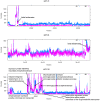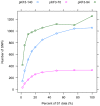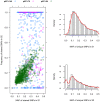Sequencing and genetic variation of multidrug resistance plasmids in Klebsiella pneumoniae
- PMID: 20405037
- PMCID: PMC2853573
- DOI: 10.1371/journal.pone.0010141
Sequencing and genetic variation of multidrug resistance plasmids in Klebsiella pneumoniae
Abstract
Background: The development of multidrug resistance is a major problem in the treatment of pathogenic microorganisms by distinct antimicrobial agents. Characterizing the genetic variation among plasmids from different bacterial species or strains is a key step towards understanding the mechanism of virulence and their evolution.
Results: We applied a deep sequencing approach to 206 clinical strains of Klebsiella pneumoniae collected from 2002 to 2008 to understand the genetic variation of multidrug resistance plasmids, and to reveal the dynamic change of drug resistance over time. First, we sequenced three plasmids (70 Kb, 94 Kb, and 147 Kb) from a clonal strain of K. pneumoniae using Sanger sequencing. Using the Illumina sequencing technology, we obtained more than 17 million of short reads from two pooled plasmid samples. We mapped these short reads to the three reference plasmid sequences, and identified a large number of single nucleotide polymorphisms (SNPs) in these pooled plasmids. Many of these SNPs are present in drug-resistance genes. We also found that a significant fraction of short reads could not be mapped to the reference sequences, indicating a high degree of genetic variation among the collection of K. pneumoniae isolates. Moreover, we identified that plasmid conjugative transfer genes and antibiotic resistance genes are more likely to suffer from positive selection, as indicated by the elevated rates of nonsynonymous substitution.
Conclusion: These data represent the first large-scale study of genetic variation in multidrug resistance plasmids and provide insight into the mechanisms of plasmid diversification and the genetic basis of antibiotic resistance.
Conflict of interest statement
Figures






Similar articles
-
Emergence of a novel conjugative hybrid virulence multidrug-resistant plasmid in extensively drug-resistant Klebsiella pneumoniae ST15.Int J Antimicrob Agents. 2020 Jun;55(6):105952. doi: 10.1016/j.ijantimicag.2020.105952. Epub 2020 Apr 23. Int J Antimicrob Agents. 2020. PMID: 32335274
-
Molecular Analysis of Antibiotic Resistance Determinants and Plasmids in Malaysian Isolates of Multidrug Resistant Klebsiella pneumoniae.PLoS One. 2015 Jul 23;10(7):e0133654. doi: 10.1371/journal.pone.0133654. eCollection 2015. PLoS One. 2015. PMID: 26203651 Free PMC article.
-
Outbreak of KPC-2-Producing Klebsiella pneumoniae ST76 Isolates in an Intensive Care Unit and Neurosurgery Unit.Microb Drug Resist. 2020 Sep;26(9):1009-1018. doi: 10.1089/mdr.2019.0363. Epub 2020 Mar 4. Microb Drug Resist. 2020. PMID: 32150494
-
Dissemination and Stability of the blaNDM-5-Carrying IncX3-Type Plasmid among Multiclonal Klebsiella pneumoniae Isolates.mSphere. 2020 Nov 4;5(6):e00917-20. doi: 10.1128/mSphere.00917-20. mSphere. 2020. PMID: 33148824 Free PMC article.
-
Insights into the evolution of gene organization and multidrug resistance from Klebsiella pneumoniae plasmid pKF3-140.Gene. 2013 Apr 25;519(1):60-6. doi: 10.1016/j.gene.2013.01.050. Epub 2013 Feb 9. Gene. 2013. PMID: 23402892
Cited by
-
Characterization of Klebsiella sp. strain 10982, a colonizer of humans that contains novel antibiotic resistance alleles and exhibits genetic similarities to plant and clinical Klebsiella isolates.Antimicrob Agents Chemother. 2014;58(4):1879-88. doi: 10.1128/AAC.01605-13. Epub 2014 Jan 6. Antimicrob Agents Chemother. 2014. PMID: 24395222 Free PMC article.
-
Identification and characterization of two novel bla(KLUC) resistance genes through large-scale resistance plasmids sequencing.PLoS One. 2012;7(10):e47197. doi: 10.1371/journal.pone.0047197. Epub 2012 Oct 9. PLoS One. 2012. PMID: 23056610 Free PMC article.
-
A Clinical Extensively-Drug Resistant (XDR) Escherichia coli and Role of Its β-Lactamase Genes.Front Microbiol. 2020 Dec 10;11:590357. doi: 10.3389/fmicb.2020.590357. eCollection 2020. Front Microbiol. 2020. PMID: 33362736 Free PMC article.
-
Genetic characterization of three qnrS1-harbouring multidrug-resistance plasmids and qnrS1-containing transposons circulating in Ho Chi Minh City, Vietnam.J Med Microbiol. 2015 Aug;64(8):869-878. doi: 10.1099/jmm.0.000100. J Med Microbiol. 2015. PMID: 26272054 Free PMC article.
-
Prevalence of blaKPC and its occurrence with other beta-lactamases in Klebsiella pneumoniae.J Lab Physicians. 2018 Oct-Dec;10(4):387-391. doi: 10.4103/JLP.JLP_29_18. J Lab Physicians. 2018. PMID: 30498308 Free PMC article.
References
-
- Shen P, Jiang Y, Zhou Z, Zhang J, Yu Y, et al. Complete nucleotide sequence of pKP96, a 67 850 bp multiresistance plasmid encoding qnrA1, aac(6′)-Ib-cr and blaCTX-M-24 from Klebsiella pneumoniae. J Antimicrob Chemother. 2008;62:1252–1256. - PubMed
Publication types
MeSH terms
LinkOut - more resources
Full Text Sources

